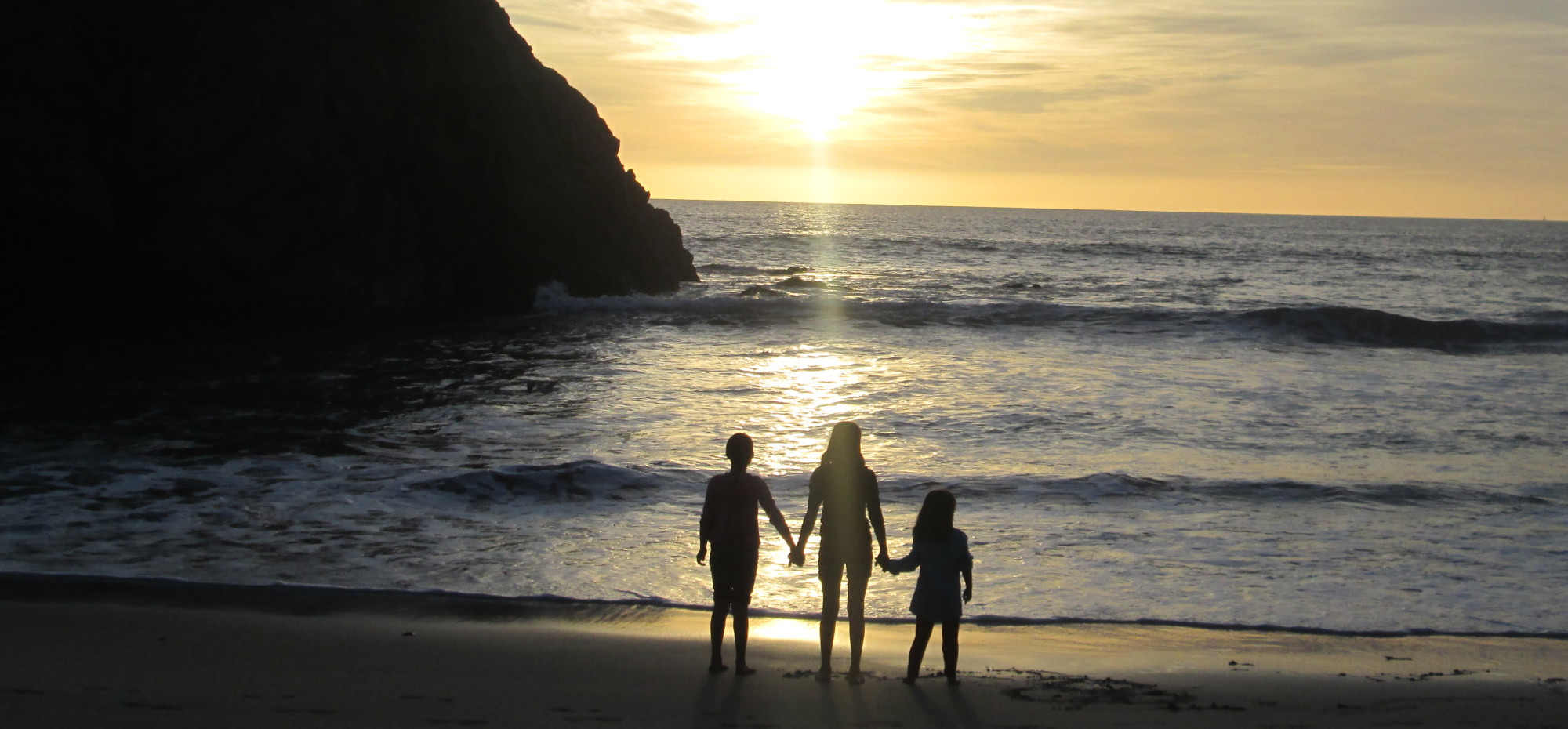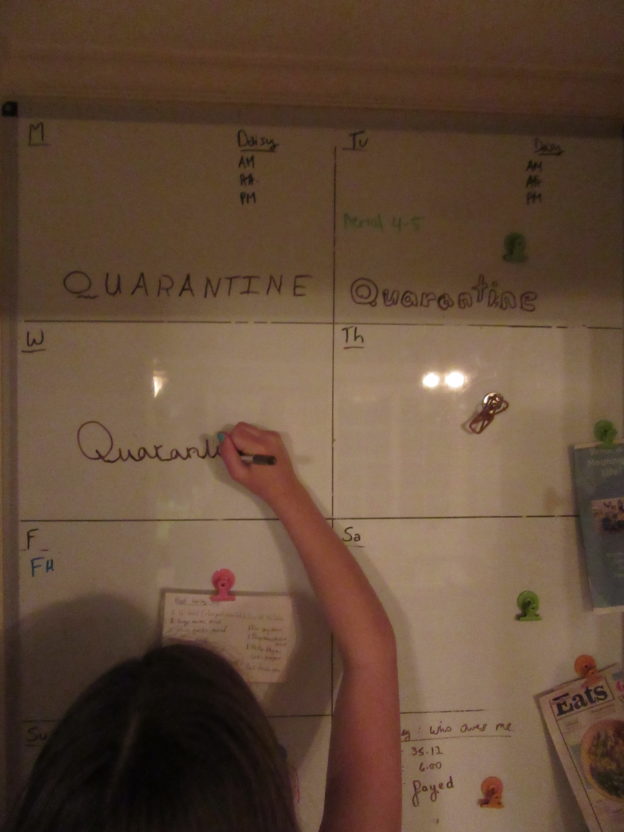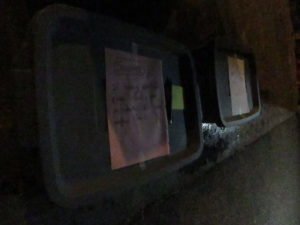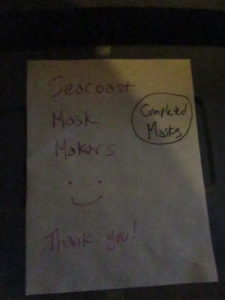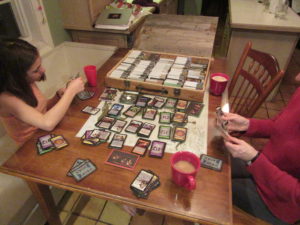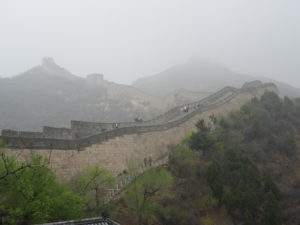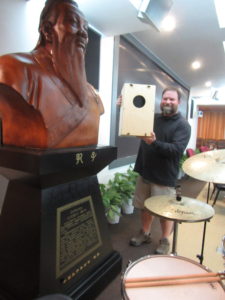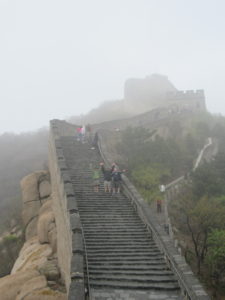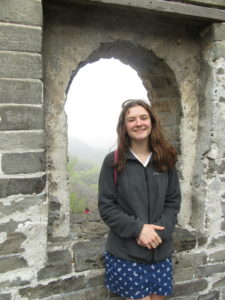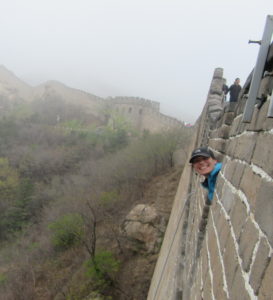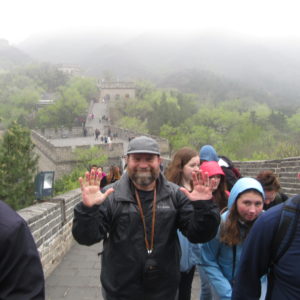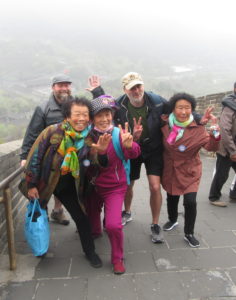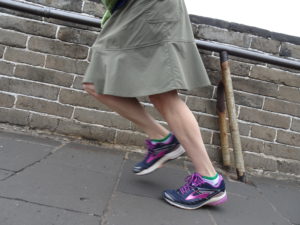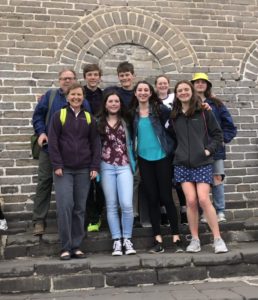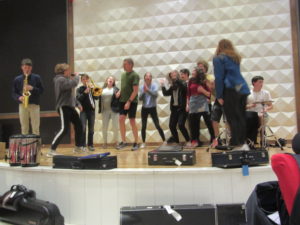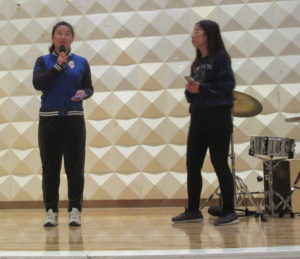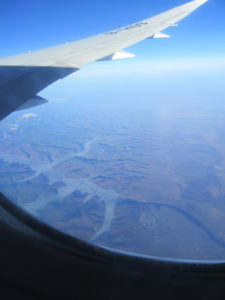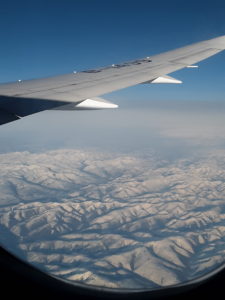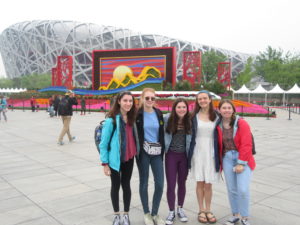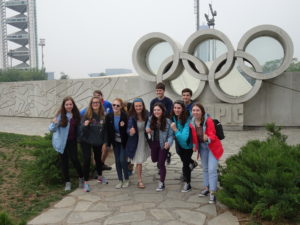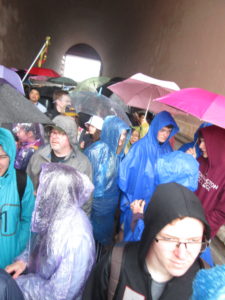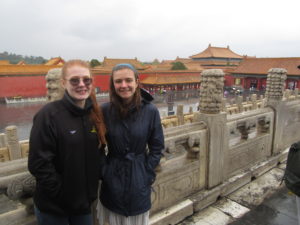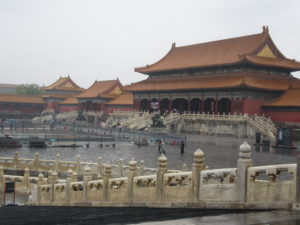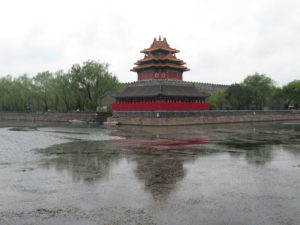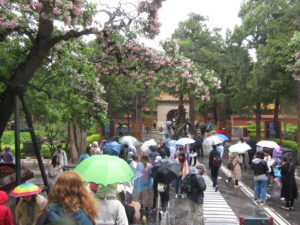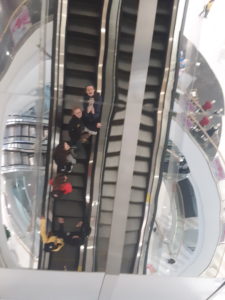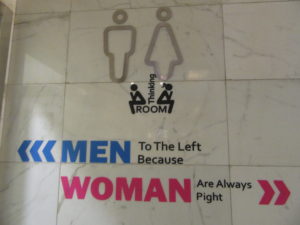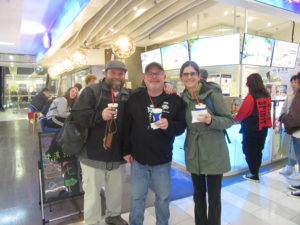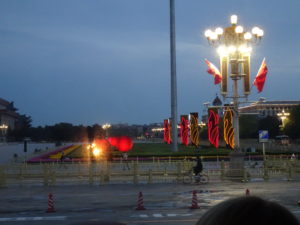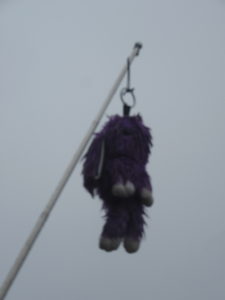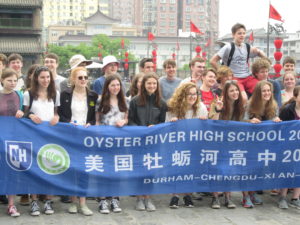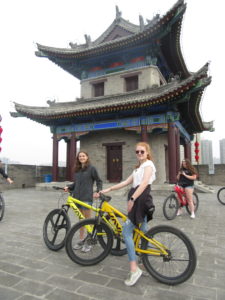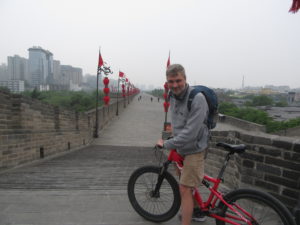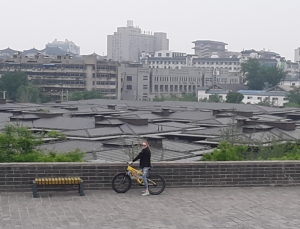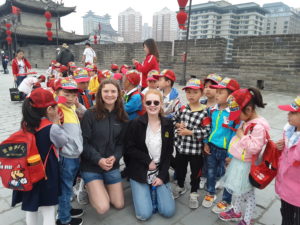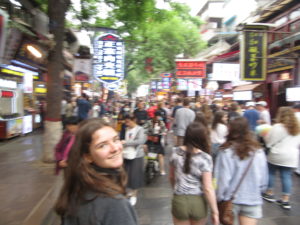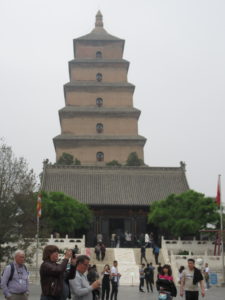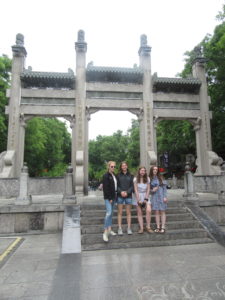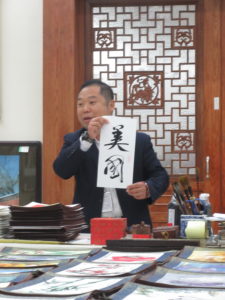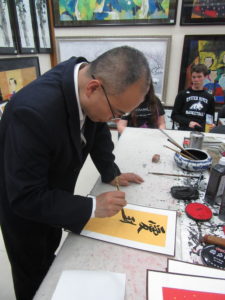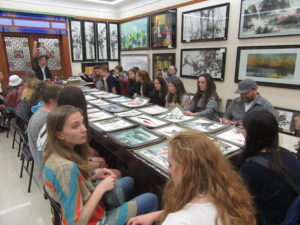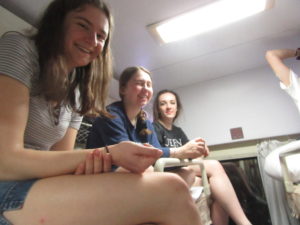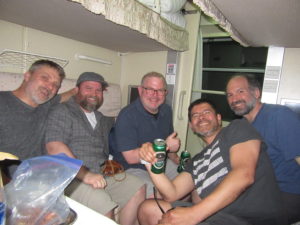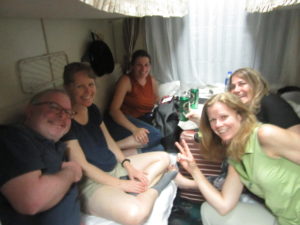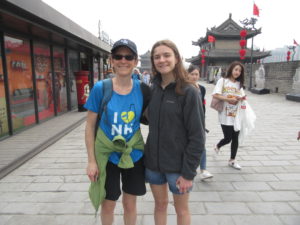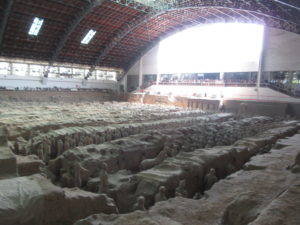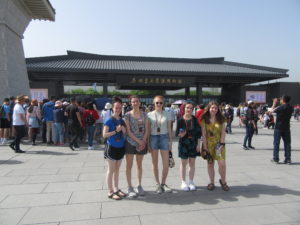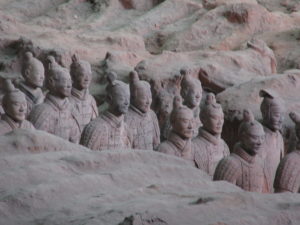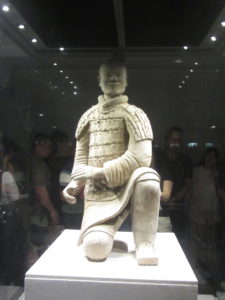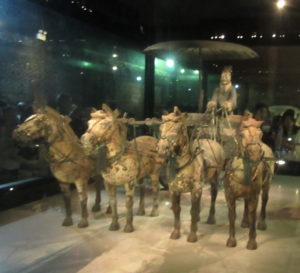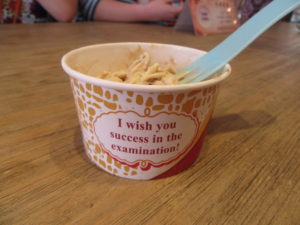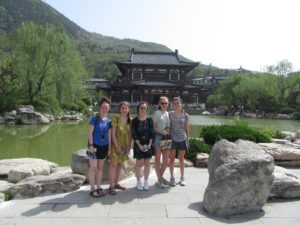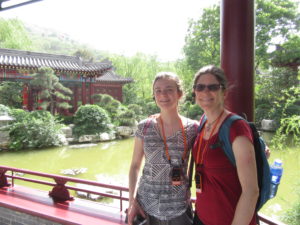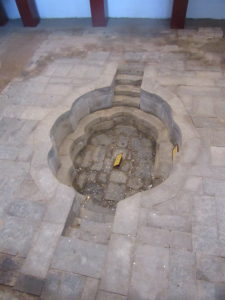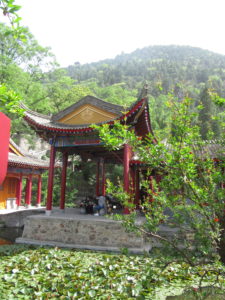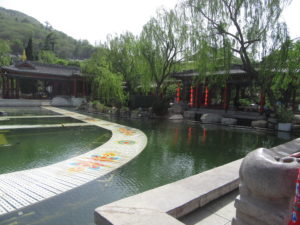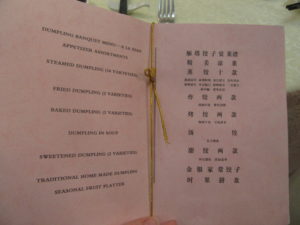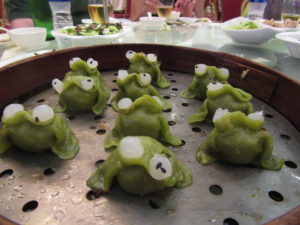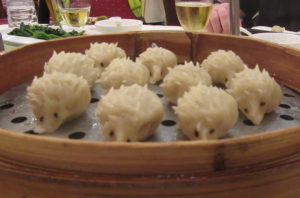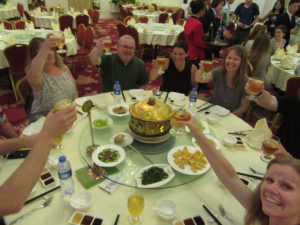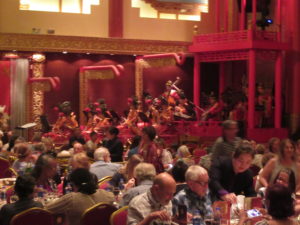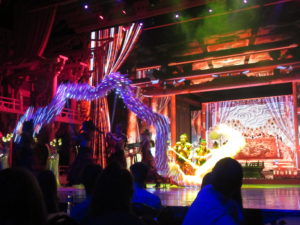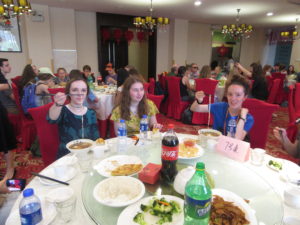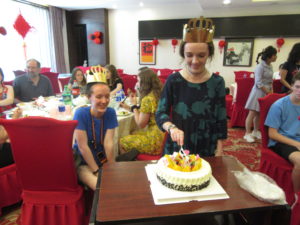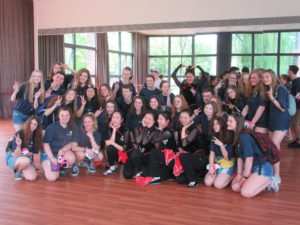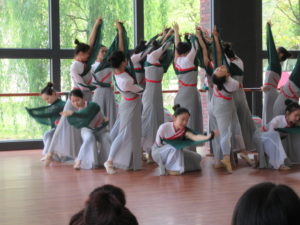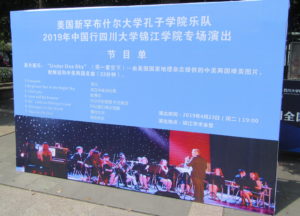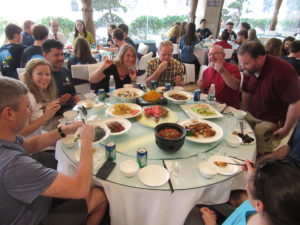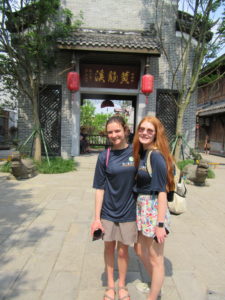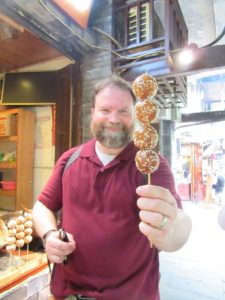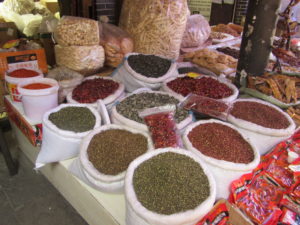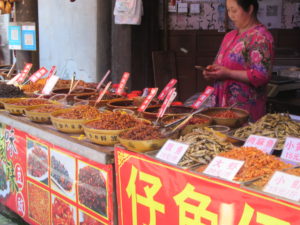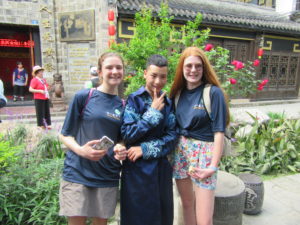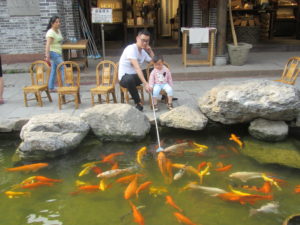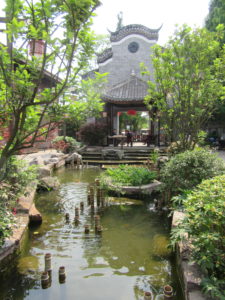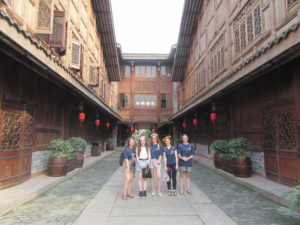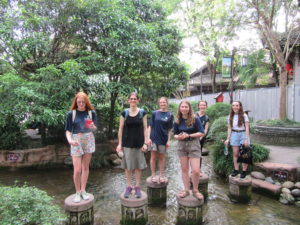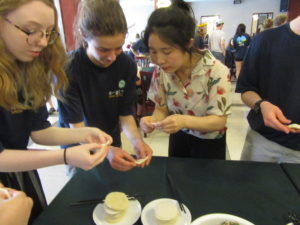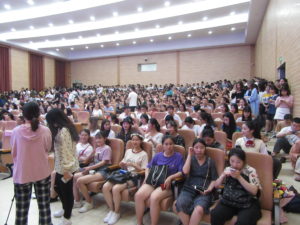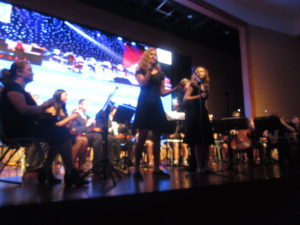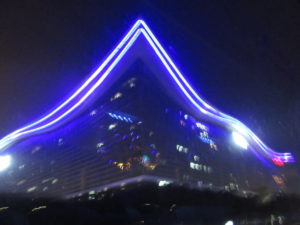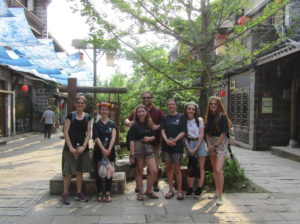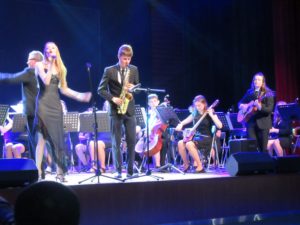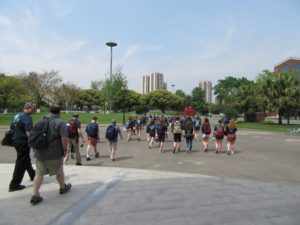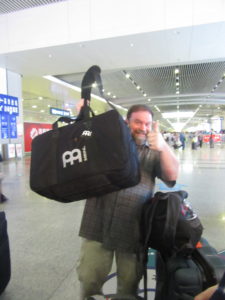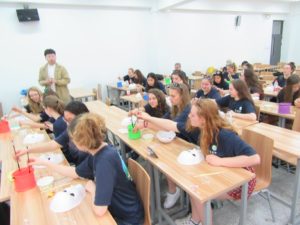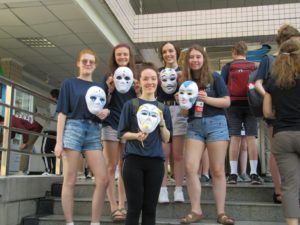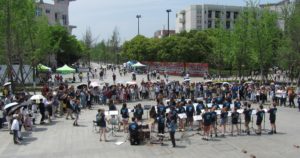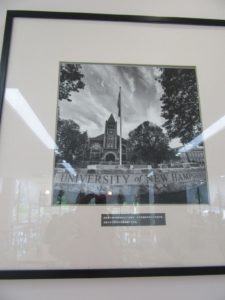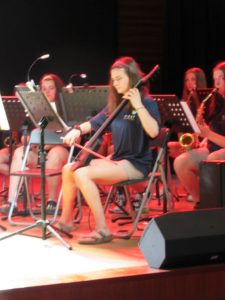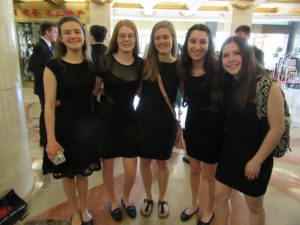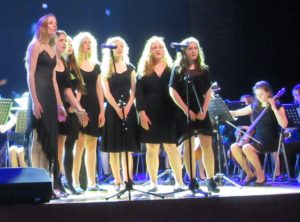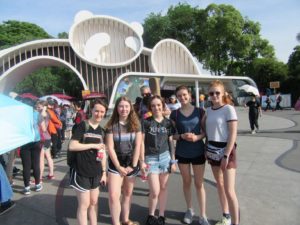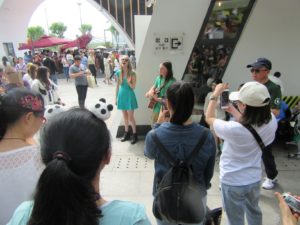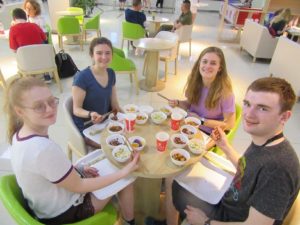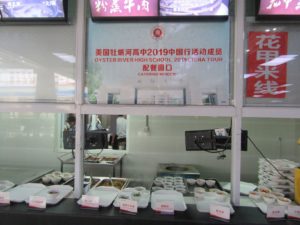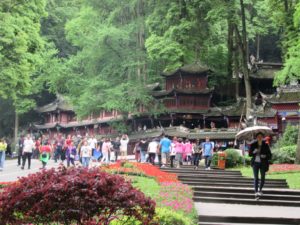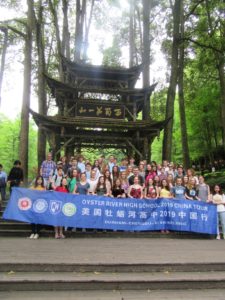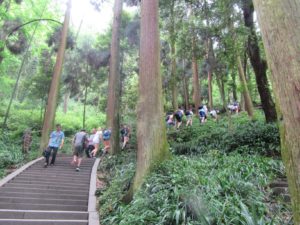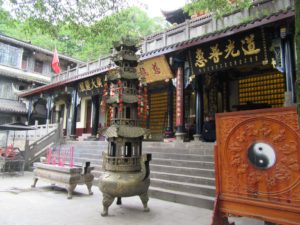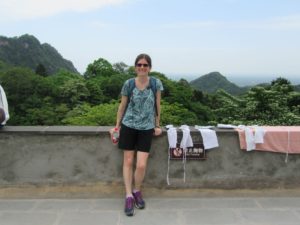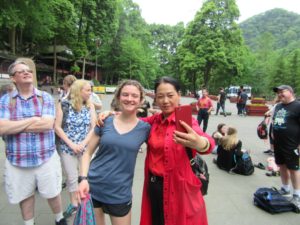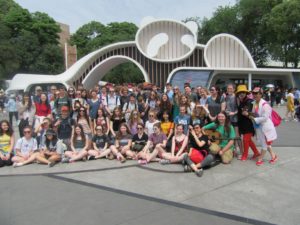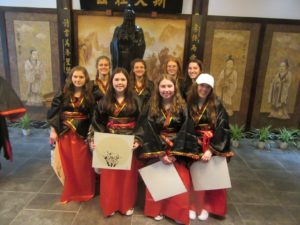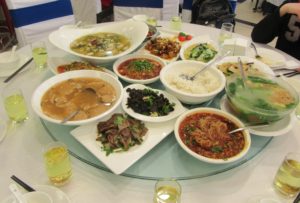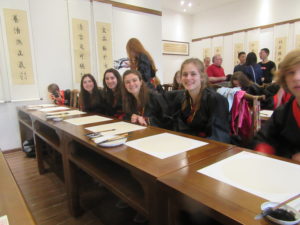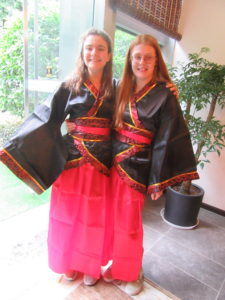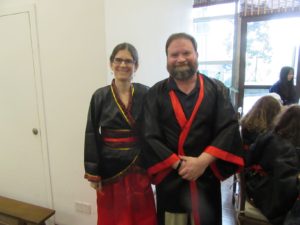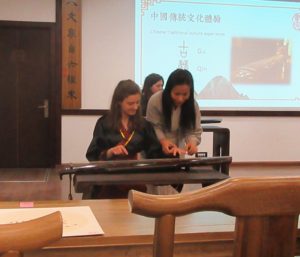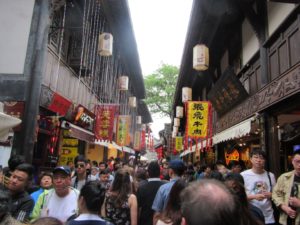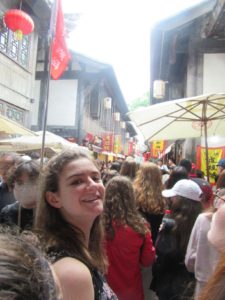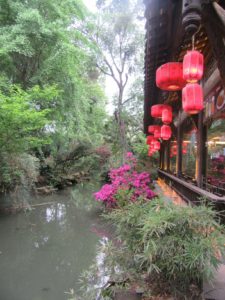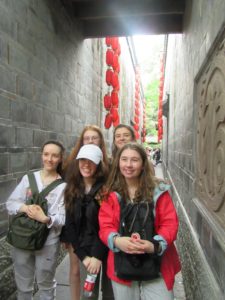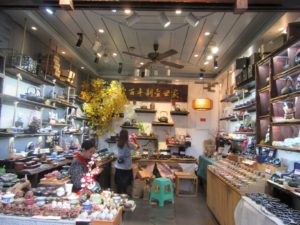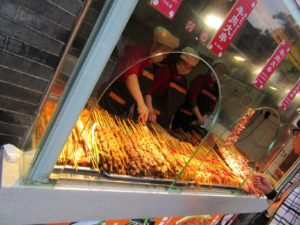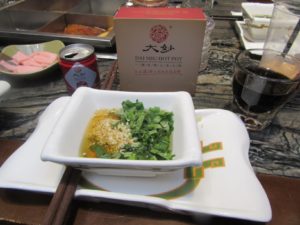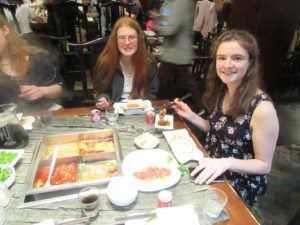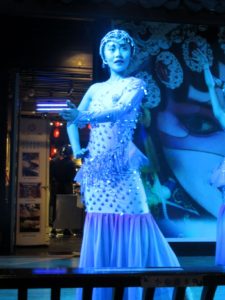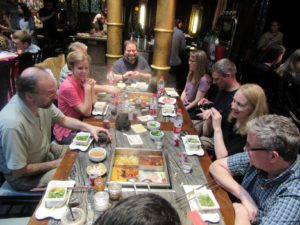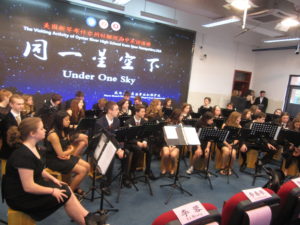 Another day, another early morning, another performance. The kids continue to hold up amazingly well, for the fifth performance within two and a half days. This time we were headed to a bilingual elementary school in Chengdu. The cute little kids in their matching uniforms provided a different kind of audience than the college students, but no less enthusiastic.
Another day, another early morning, another performance. The kids continue to hold up amazingly well, for the fifth performance within two and a half days. This time we were headed to a bilingual elementary school in Chengdu. The cute little kids in their matching uniforms provided a different kind of audience than the college students, but no less enthusiastic.
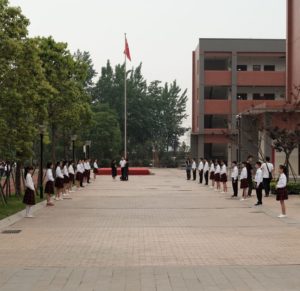 When we arrived on our buses there were already students positioned in two lines on either side of the entrance path, clapping for us as we made our way into the school. Soon all the different classes were jogging out onto the field in formation, smiling and waving to us, with a space of honor reserved for us in the center. After watching the small Chinese children effortlessly form neat, evenly-spaced lines, we attempted to marshal our straggling crew into some kind of order as well.
When we arrived on our buses there were already students positioned in two lines on either side of the entrance path, clapping for us as we made our way into the school. Soon all the different classes were jogging out onto the field in formation, smiling and waving to us, with a space of honor reserved for us in the center. After watching the small Chinese children effortlessly form neat, evenly-spaced lines, we attempted to marshal our straggling crew into some kind of order as well.
We were first treated to dance, kung fu, and face-changing performances from the 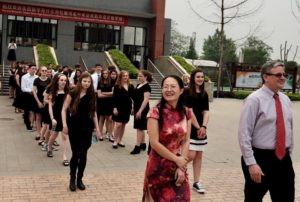 students and teachers. During the face-changing show, the star’s mask switches in the blink of an eye, like magic. From the audience, it’s perplexing to contemplate how it’s done. The star of this particular show could not have been more than nine or ten, so it was particularly impressive. (We also admired his fortitude in dancing around in a heavy costume, headpiece, and mask in full sun on another ninety-degree day.)
students and teachers. During the face-changing show, the star’s mask switches in the blink of an eye, like magic. From the audience, it’s perplexing to contemplate how it’s done. The star of this particular show could not have been more than nine or ten, so it was particularly impressive. (We also admired his fortitude in dancing around in a heavy costume, headpiece, and mask in full sun on another ninety-degree day.)
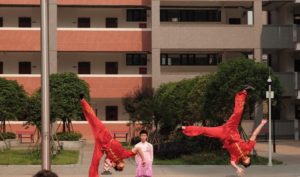 Our performance was inside in the auditorium. There was not room for all the students, so only a small number were able to attend in person — but the performance was live-streamed to all the other classrooms. As with our other shows, the first few rows were reserved for various dignitaries from the school and local government.
Our performance was inside in the auditorium. There was not room for all the students, so only a small number were able to attend in person — but the performance was live-streamed to all the other classrooms. As with our other shows, the first few rows were reserved for various dignitaries from the school and local government.
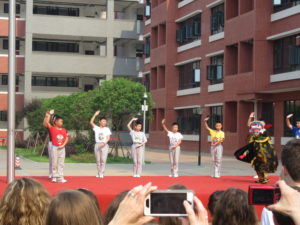 There is a high level of formality here that we’ve seen with each of our performances. Mr. Ervin knew there would be exchanging of gifts, so he brought along a beautiful carved wooden eagle he’d commissioned from the school shop teacher, a talented wood-worker. Beyond that we had a bit of a random grab bag — a few moose stuffed animals, a whole pile of pottery made by high school art students, a bunch of T-shirts apparently pulled out of the middle school supply closet, and a few “Durham” T-shirts that Al picked up at Rite Aid right before the trip. (This was chaperone Al, not percussion suitcase Al. The latter did not provide any gifts at all.) These were distributed to chaperones and a few students to carry in our luggage.
There is a high level of formality here that we’ve seen with each of our performances. Mr. Ervin knew there would be exchanging of gifts, so he brought along a beautiful carved wooden eagle he’d commissioned from the school shop teacher, a talented wood-worker. Beyond that we had a bit of a random grab bag — a few moose stuffed animals, a whole pile of pottery made by high school art students, a bunch of T-shirts apparently pulled out of the middle school supply closet, and a few “Durham” T-shirts that Al picked up at Rite Aid right before the trip. (This was chaperone Al, not percussion suitcase Al. The latter did not provide any gifts at all.) These were distributed to chaperones and a few students to carry in our luggage.
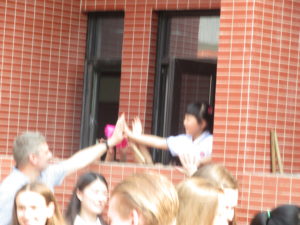 Things started out well at Chengdu University. The ranking dignitary and Mr. Ervin made lovely speeches and exchanged gifts. The carved eagle was duly presented. However, things went downhill at Sichuan University. They presented us with a beautiful piece of artwork on a scroll, with an accompanying speech about the significance of this form of art — and there we were, standing with some random pottery items and a few T-shirts. I think those on the stage wanted to sink through the floor — and some of us in the audience did as well.
Things started out well at Chengdu University. The ranking dignitary and Mr. Ervin made lovely speeches and exchanged gifts. The carved eagle was duly presented. However, things went downhill at Sichuan University. They presented us with a beautiful piece of artwork on a scroll, with an accompanying speech about the significance of this form of art — and there we were, standing with some random pottery items and a few T-shirts. I think those on the stage wanted to sink through the floor — and some of us in the audience did as well.
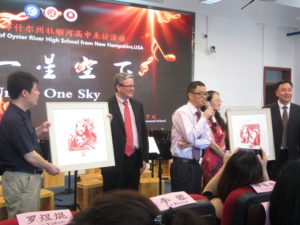 Things got even worse at the school. Not only did they present Mr. Ervin with two large framed prints of pandas, with the usual speech about the artist and the history of the art form — but they then called all the chaperones up in front and gave each of us a panda print as well. (Lord knows how I will get it home, since it doesn’t fit in my suitcase.) Mr. Ervin did his best to rescue our stuffed animal presentation by adlibbing a speech about the local significance and noble character of the moose, but it was pretty hopeless. (At our final performance in Beijing the other day, we all just quietly left our remaining pottery and T-shirts on a table in the back of the room and sneaked away — after lugging them around for days, we certainly had no plans of lugging them back home again.)
Things got even worse at the school. Not only did they present Mr. Ervin with two large framed prints of pandas, with the usual speech about the artist and the history of the art form — but they then called all the chaperones up in front and gave each of us a panda print as well. (Lord knows how I will get it home, since it doesn’t fit in my suitcase.) Mr. Ervin did his best to rescue our stuffed animal presentation by adlibbing a speech about the local significance and noble character of the moose, but it was pretty hopeless. (At our final performance in Beijing the other day, we all just quietly left our remaining pottery and T-shirts on a table in the back of the room and sneaked away — after lugging them around for days, we certainly had no plans of lugging them back home again.)
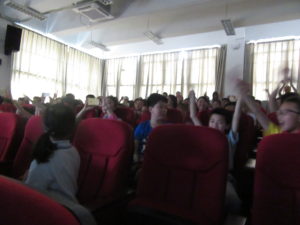 The group pulled off another great performance, and Zoe managed to keep her electric cello operational throughout. The pop song portion of the program is incredibly high-energy, and it’s amazing that the kids can pull this off day after day. They’ll now be able to relax a bit, since the bulk of the performing is now over. There’s only one more small concert in Beijing at the end of the trip — until then, we have a few days to tour and relax.
The group pulled off another great performance, and Zoe managed to keep her electric cello operational throughout. The pop song portion of the program is incredibly high-energy, and it’s amazing that the kids can pull this off day after day. They’ll now be able to relax a bit, since the bulk of the performing is now over. There’s only one more small concert in Beijing at the end of the trip — until then, we have a few days to tour and relax.
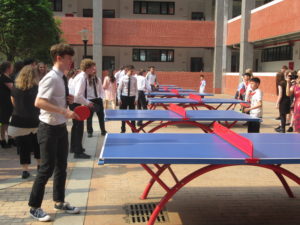 After the concert we had a mini ping pong tournament with some of the kids from the school. They were clearly throttling their skill level, and as soon as any opponent showed the slightest bit of skill they would ratchet up their own level accordingly. After all the movie star treatment, it was a good ego check to find all of us getting crushed by nine-year-olds.
After the concert we had a mini ping pong tournament with some of the kids from the school. They were clearly throttling their skill level, and as soon as any opponent showed the slightest bit of skill they would ratchet up their own level accordingly. After all the movie star treatment, it was a good ego check to find all of us getting crushed by nine-year-olds.
It was also time to say goodbye to Chengdu. Originally we were to have taken an overnight train to Xi’an, our next destination — but it was changed to a bullet train because of logistical issues. (The jury was still out on what kind of train we’ll be taking to Beijing for the final leg of the trip.) Though I was a little sad to miss out on the romance of the sleeper train, it was also pretty cool to take a train that travels 200 miles per hour.
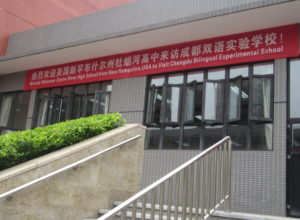 First, though, we had to make it through the train station. This proved to be the most stressful experience of the trip. It was mobbed with people, it was not clear where to go, there were several different security checks, and generally chaos everywhere. We were all laden with lots of luggage/instruments/etc. Our Chinese helpers had their hands full trying to get the full group of us through security and checked in on time. At one point my group went through a security check and six out of the seven of us had our luggage pulled aside to a table where security
First, though, we had to make it through the train station. This proved to be the most stressful experience of the trip. It was mobbed with people, it was not clear where to go, there were several different security checks, and generally chaos everywhere. We were all laden with lots of luggage/instruments/etc. Our Chinese helpers had their hands full trying to get the full group of us through security and checked in on time. At one point my group went through a security check and six out of the seven of us had our luggage pulled aside to a table where security
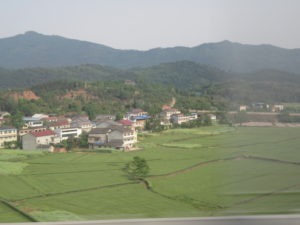
Chinese countryside, as seen from the train
personnel were standing. However, they pretty much ignored us so we were completely unclear on what to do next. We heard from someone else that we had something in our luggage that wasn’t allowed, but were given no guidance as to what that might be. Claire had to give up her perfume in a glass bottle, but none of the rest of us had any idea. We were reduced to holding up random items for our Chinese helper to check on (nail clippers? a razor? bug spray?) but never got any answers. Eventually we just picked up our bags and left the area — I figured that if someone stopped us maybe they would have to give us some guidance on what to do next, but as it turned out no one did.
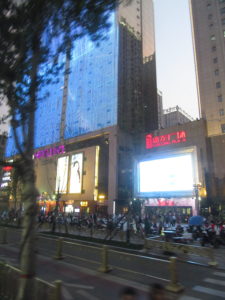
Evening arrival in Xi’an
Then we had to board the train, which proved to have no space for all our luggage. It was a massive effort for our whole large group to get large suitcases stowed away in the overhead racks, and several people ended up having to keep them in their seat with them. Sadly this was the case with Al, who was definitely too large to fit overhead. Everyone was also very nervous because our guide told us we’d have three minutes to exit the train in Xi’an before it started moving to its next stop in Beijing. Given how long it’d taken us to get ON the train, this seemed daunting. We also had been given stern instructions that basically doom would rain down on our heads if anyone lost their ticket (yeah, at least one kid lost a ticket).
Apart from all this stress, the three-hour journey went smoothly. The Chinese countryside was quite a surprise. Not far from Chengdu we got into the mountains, and the scenery outside looked more like Switzerland than what I would picture for China. There were lots of little villages of two-story houses nestled into the hills, surrounded by rivers and 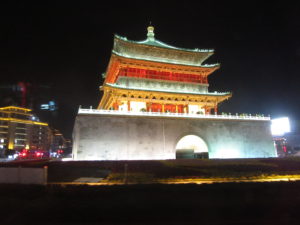 farmland. (Every now and then we’d come across a little group of identical skyscrapers, which reminded us where we were.) We spent lots of time in tunnels. It must have been a spectacularly difficult line to build.
farmland. (Every now and then we’d come across a little group of identical skyscrapers, which reminded us where we were.) We spent lots of time in tunnels. It must have been a spectacularly difficult line to build.
Xi’an is an ancient city, with history as the intermittent capital of the Chinese empire dating back 3000 years. It’s also a beautiful modern city, with the buildings and lights making it look comparable to one of the nicer sections of Manhattan. It definitely had more of an urban feel than Chengdu, despite being smaller (10 million people vs. 16 million). I was told, however, that Chengdu is actually similar but that we were staying on the outskirts and just never got to see the real urban core. The center of Xi’an is surrounded by an old city wall, and our hotel was inside this center. Each of
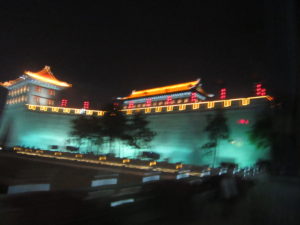
Xi’an old city walls
our two buses had a Chinese tourist guide who told us about the history of the city and kept us entertained with funny stories and songs. All of our guides here have been excellent, and have really earned their salaries staying with our group during our whole 15-hour days.
There was talk of heading into the city for some kind of outing, but in the end everyone was too tired to muster the energy for it. These travel days, when you’re responsible for sixty-something kids and all their passports and equipment, take a lot out of you. The best that we chaperones could do was to meet in the lobby for a beer and toast to a successfully completed journey.
